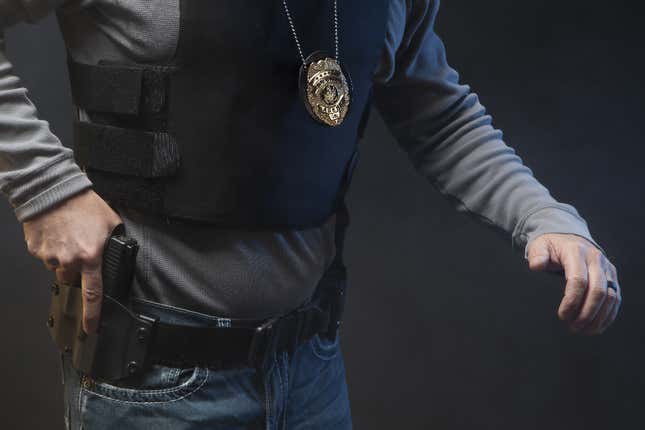
Despite a seemingly unending wave of anti-police violence protests, a pandemic that unfortunately also often seems unending and calls for police reform by politicians, activists and community members, fatal police shootings continue on a daily basis. To add insult to injury, a number of police departments across the nation are invoking laws meant to protect the identities of crime victims in order to shield the identities of cops involved in deadly shootings.
From the Washington Post:
The Washington Post began tracking fatal shootings by on-duty police officers in 2015, the year after a White officer in Ferguson, Mo., shot and killed a Black 18-year old. Over the past six years, officers have fatally shot more than 6,400 people, an average of nearly a thousand a year, or almost three each day. The yearly toll even reached a new high of 1,021 fatal shootings in 2020. Midway through this year, fatal police shootings are down compared with the same period last year. They have fluctuated month to month since the project began, ending near 1,000 annually.
The Post found that while police departments across America have taken some steps in the right direction in regards to police reform, “these efforts have been inconsistent and incomplete.” For example—and this is a big one—most police departments still don’t require the use of body cameras for police officers. And because body cameras are so seldom worn by officers and in many police-involved shootings the officers are the only survivors, cops are often able to control the narrative around fatal shooting incidents.
According to the Post, law enforcement experts say the strong majority of police shootings are justified and unavoidable and that most of those killed are armed in some way.
“The vast majority of those fatal shootings are lawful, righteous shootings,” Daniel Oates, a former police chief in Miami Beach, Ann Arbor, Mich., and the consistently embattled police department in Aurora, Colo., said. “A percentage of them are bad training, bad policy, bad day by the cop not performing at their best.”
Oates said despite the fact that more officers were charged criminally for shootings while on-duty in 2020 than they were the year prior, there has been significant improvement in policing practices.
“The narrative of the last year has been that ‘Oh my God, police are wildly out of control,’” Oates said. “That’s not true. If you tracked that [fatal shooting] data from 30, 40 years ago, I’m sure the numbers would be much, much, much, much higher. There’s been a reform movement around the use of force in American policing.”
But according to the Post, that data Oates is speculating on is incomplete.
More from the Post:
Nationwide data, however, are incomplete. Between 1976 and 2015, the FBI’s Uniform Crime Reporting Program recorded no more than 460 fatal shootings by police in any single year. The Post’s database, launched in 2015, has found more than double that number every year. The FBI’s long-promised new program meant to fill the gaps is voluntary — and still incomplete.
So this brings us back to video evidence in police shootings—of which there is very little.
According to the Post, fewer than 20 percent of fatal police shootings are caught on video, and the vast majority of these shootings don’t become national news like the case of Breonna Taylor and a few others. And since police reports and narratives are often taken at face value, the word of a cop is often treated as fact.
“They write the reports, they give the statements, and other people’s accounts are not taken seriously,” Philip Stinson, a criminology professor at Bowling Green State University in Ohio, told the Post.
Stinson said that sometimes video will disprove an officer’s official statement. He cited the case of George Floyd where officers initially released a statement saying Floyd “physically resisted officers” before “suffering medical distress”—a statement that quickly fell apart once a bystander’s video provided much-needed context.
“But in most of these cases, police still own the narrative,” Stinson said.
As mentioned earlier, cops are also often able to shield their identities after being involved in a fatal shooting. In 2018, Florida voters passed “Mary’s Law,” which allows crime victims to request that authorities keep sealed “information or records that could be used to locate or harass the victim or the victim’s family.” According to the Post, more than a dozen states have passed similar laws and many departments, particularly in Florida, have used the laws to shield officers involved in shootings, despite that clearly not being what the laws are intended for.
The Post used as an example the case of 20-year-old Ryan Fallo, who was suspected of cutting an Uber driver with a knife and stealing the driver’s car. Fallo was fatally shot by sheriff’s deputies in Palm Beach County. The Sheriff’s office said he ignored commands to drop his knife and approached officers with it. The shooting was later ruled justified, but the gag is, the two officers involved were never publicly identified because, in the paperwork, they both signed their names in the space marked “Signature of Victim,” claiming protection under Mary’s Law.
It’s worth mentioning that police shootings are not the only types of police violence being protested against. Floyd wasn’t shot. Elijah McClain wasn’t shot. Eric Garner wasn’t shot. Freddie Gray wasn’t shot.
As for the shootings, it just doesn’t seem like we’ll ever know the unedited truth on whether things are getting better or not.

